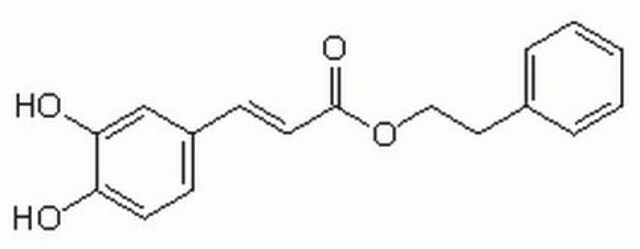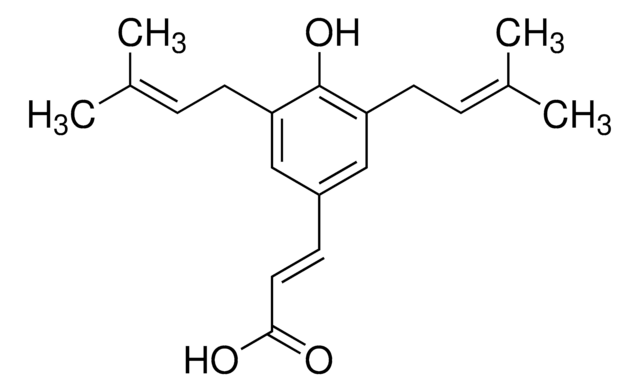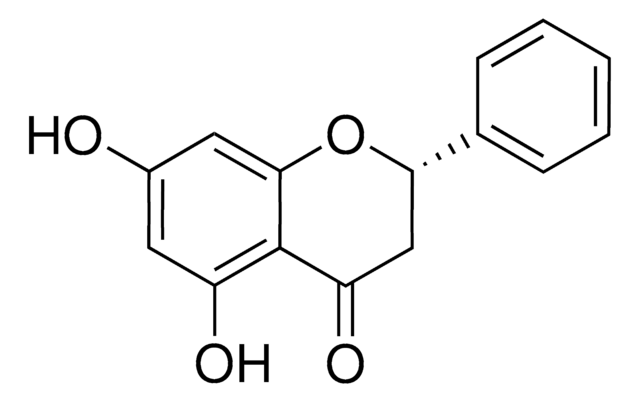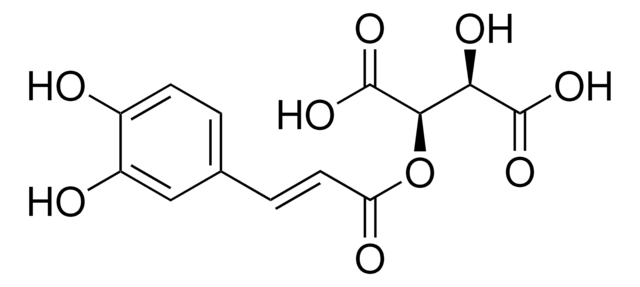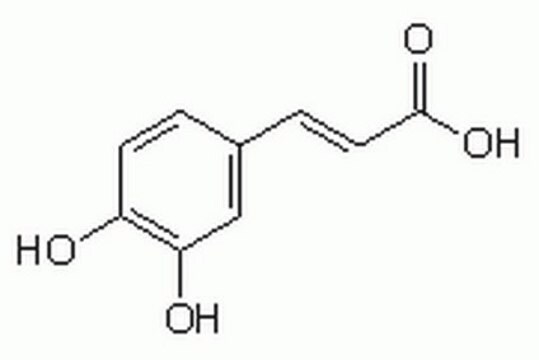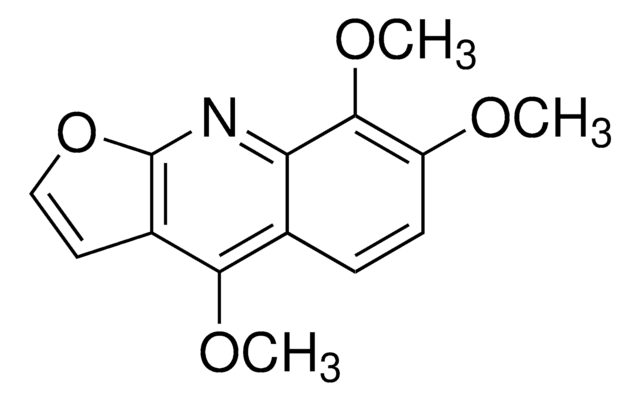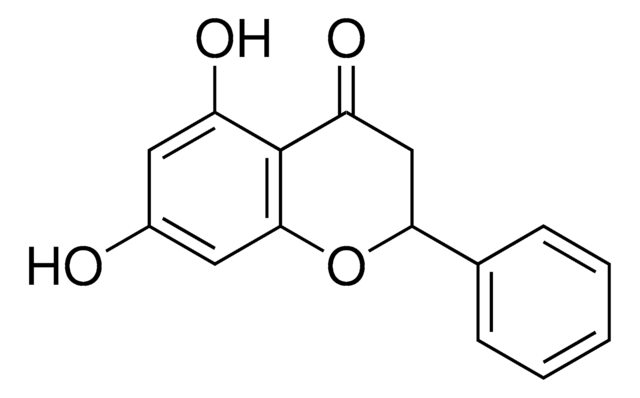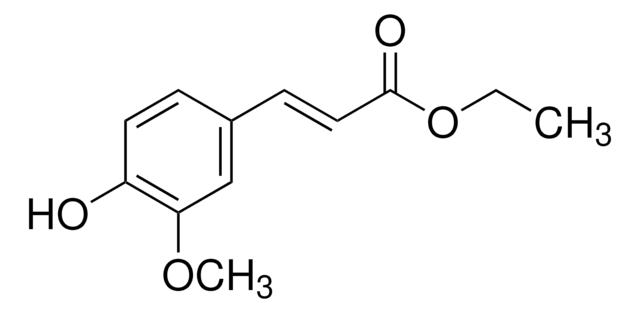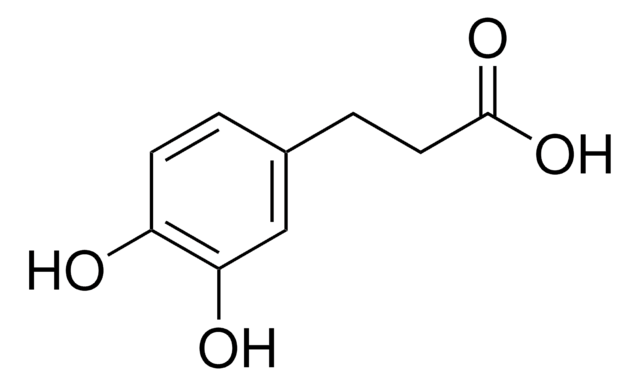C8221
Caffeic acid phenethyl ester
≥97% (HPLC), powder
Synonym(s):
CAPE
Sign Into View Organizational & Contract Pricing
All Photos(1)
About This Item
Empirical Formula (Hill Notation):
C17H16O4
CAS Number:
Molecular Weight:
284.31
MDL number:
UNSPSC Code:
12352108
PubChem Substance ID:
NACRES:
NA.77
Recommended Products
biological source
synthetic
Quality Level
Assay
≥97% (HPLC)
form
powder
storage condition
protect from light
color
off-white
solubility
ethyl acetate: 50 mg/mL
DMSO: soluble
ethanol: soluble
storage temp.
−20°C
SMILES string
Oc1ccc(\C=C\C(=O)OCCc2ccccc2)cc1O
InChI
1S/C17H16O4/c18-15-8-6-14(12-16(15)19)7-9-17(20)21-11-10-13-4-2-1-3-5-13/h1-9,12,18-19H,10-11H2/b9-7+
InChI key
SWUARLUWKZWEBQ-VQHVLOKHSA-N
Gene Information
human ... NFKB2(4791)
Application
Caffeic acid phenethyl ester (CAPE) has been used to determine the effect of CAPE in hyperthyroidism, as a component of culture media to measure the cytotoxicity of breast cancer cell line MDA-MB-231, to study its effects on amiodarone-induced pulmonary fibrosis in rats.
Biochem/physiol Actions
CAPE exhibits several properties such as anticarcinogenic, immunomodulatory activities, antioxidant, antiviral, anti-inflammatory, hypoglycaemic effect, cardioprotective and inhibits gastric secretion. It also has an inhibitory effect on fibroblasts growth factor type 2 (FGF-2), a tumor growth factor in breast cancer.
Caffeic acid phenethyl ester is a specific inhibitor of the nuclear transcription factor NF-κB.
Features and Benefits
This compound is a featured product for Gene Regulation research. Click here to discover more featured Gene Regulation products. Learn more about bioactive small molecules for other areas of research at sigma.com/discover-bsm.
Storage Class Code
11 - Combustible Solids
WGK
WGK 3
Flash Point(F)
Not applicable
Flash Point(C)
Not applicable
Personal Protective Equipment
dust mask type N95 (US), Eyeshields, Gloves
Choose from one of the most recent versions:
Already Own This Product?
Find documentation for the products that you have recently purchased in the Document Library.
Customers Also Viewed
Z Z Su et al.
Anticancer research, 15(5B), 1841-1848 (1995-09-01)
The active component of the folk medicine propolis, caffeic acid phenethyl ester (CAPE), displays selective toxicity toward cloned rat embryo fibroblast (CREF) cells transformed by a spectrum of diverse acting oncogenes. Identification of the mode of action of CAPE should
Mehdi Derakhshani et al.
Life sciences, 232, 116598-116598 (2019-06-28)
Hematopoietic stem cells (HSCs) are a rare cell population in adult bone marrow, mobilized peripheral blood, and umbilical cord blood possessing self-renewal and differentiation capability into a full spectrum of blood cells. Bone marrow HSC transplantation has been considered as
Protective effect of caffeic acid phenethyl ester (CAPE) on amiodarone-induced pulmonary fibrosisin rat
Zaeemzadeh N, et al.
Iranian Journal of Pharmaceutical Research : IJPR, 10(2), 321-321 (2011)
Migration rate inhibition of breast cancer cells treated by caffeic acid and caffeic acid phenethyl ester: an in vitro comparison study
Kabala-Dzik A, et al.
Nutrients, 9(10), 1144-1144 (2017)
Z Z Su et al.
Cancer research, 54(7), 1865-1870 (1994-04-01)
The active component of the honeybee hive product propolis, caffeic acid phenethyl ester (CAPE), induces a selective growth suppressive and toxic effect toward cloned rat embryo fibroblast cells transformed by adenovirus type 5 (Ad5) or the Ad5 E1A transforming gene
Articles
NF-κB and Inflammation
Our team of scientists has experience in all areas of research including Life Science, Material Science, Chemical Synthesis, Chromatography, Analytical and many others.
Contact Technical Service